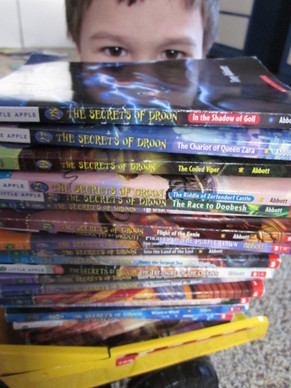When we first began reading these books – my youngest son couldn’t independently read the text (which is leveled at approximately 2nd or 3rd grade). He waited patiently for me to sit with him or begged his brother to indulge him by reading aloud. In a pinch, I was even known to hand the nine year-old a buck as a bribe to read aloud to his sibling while I cooked-up dinner.
Little by little, as my youngest has gained new reading skills, he has independently checked in with these books to see if he can conquer them alone. The series became his great motivator: his personal goal was to read a Droon book on his own before the summer after 1st grade.
I think he’ll just make it!
When I explain the Secrets of Droon series to other Moms, I always disclose two main points:
1) Droon is like ‘Harry Potter’- but for the younger set.
Three young children find themselves in a magical world of adventure, danger, and mystery! There are good wizards and bad wizards. There is a magical door between our world and theirs. You root for the hero and wonder how they’ll ever defeat the enemy.
2) Droon is not great literature.
So many twists, turns, characters, subplots, secrets, reveals, and dream sequences -- I can barely keep up. However, the kid-friendly suspense does hook young readers like nobody’s business.
Of course, with this series (as with all chapter books), I involved my boy in the ‘reading’ from the very start. Below are a few of the pre-reader activities that I used as soon as we began to enjoy this series. Activities like this can help develop the ‘reading readiness’ skills that will provide a foundation for later success.
1) Explore the Title Page.
Toddlers: Point to the title as you read it aloud. Talk about how the Title Page is similar to the book’s front cover.
Preschoolers: Point to the name of the author while you say it aloud and show your child a picture of the author (if it is available on the inside of the back cover.) If there is a series logo, draw attention this mark and ask about it each time you read one of the books included. Just as a child can ‘read’ the golden arches of McDonald’s – they can recognize the symbol designate to a book series.
Beginning Readers: Now include your child in the reading of the title. They should be able to begin read small words like... the, it, and, or on. You can also model ‘sounding out’ any words that follow simple phonetic rules. As your child’s skills progress, have them take charge of reading the title aloud in full before you begin reading the story. In addition, ask your child to predict what the title and the picture on the front cover might be revealing about the story inside.
2) Investigate the Table of Contents.
Toddlers: Point to the title of each chapter as you read them aloud. Count (aloud) the number of chapters and note how you can find the page on which each begins.
Preschoolers:Ask your child to count the number of chapters that are in the book. Point to a chapter – read its title out loud – and ask your child to say the number of the page where it will begin. Do this for several of the chapters (in no particular order).
Beginning Readers: Now include your child in the reading of the titles. Without pointing at a particular chapter, just read aloud its name and ask your child to identify its page number start. As your child becomes more familiar with this task, turn these questions around and say a page number before asking them to find the corresponding chapter’s title. Ask your child to predict what may happen in the book based on the all the chapter title names.
3) Starting Each Chapter
Toddlers: Ask your child to identify the number printed at the start of the chapter. You could also point to the page number and read that number aloud to them. Point to the chapter title as you read it aloud.
Preschoolers: Ask your child to identify the page number. Turn back to the Table of Contents and show them where this information is noted. Ask them how many chapter have been read before this one and how many will follow.
Beginning Readers: Slowly release responsibility of reading the chapter number and titles to your child. This will soon become automatic. When ready, ask them to start also taking responsibility for the first sentence. This gradual shift is key when your child has enough skill to read the words, but not enough practice to read the text fast enough to enjoy the plot. The act of reading the chapter’s title and first sentence involves them, but doesn’t overwhelm them. They can enjoy the story line, but also become aware of their own progress and growing ability to tackle the words on the printed page.
Finally, here’s a video of my son and I talking though many of these same activities. After talking through these activities with my son (month after month), he’s an old pro. It’s proof positive that every bit of reading practice squeezed-in, can help prepare a child for the independent reading that lies ahead.


 RSS Feed
RSS Feed